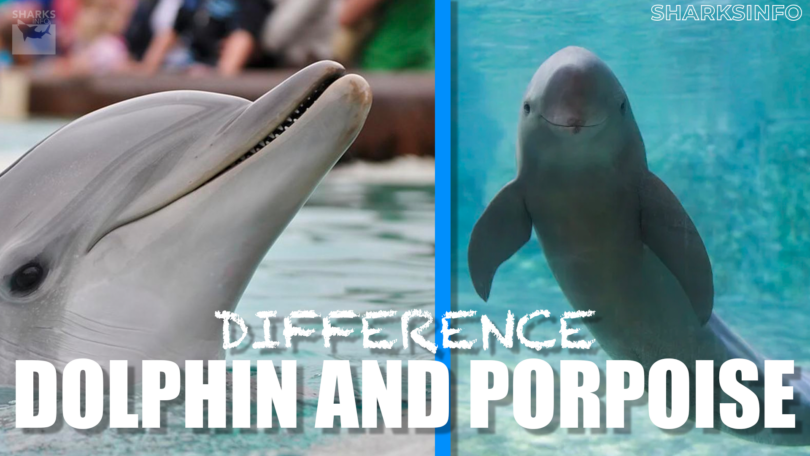Dolphin or Porpoise? Confused? When you see a porpoise, have you ever thought is it a dolphin? People often refer the dolphins and porpoises as the same marine animals. They both share similarities; they are mammals, live in water, and have fins and flippers. They are members of the Cetacea order whose name is derived from the Greek word ketos means “Large Sea Creatures”. However, there are notable differences in terms of the appearance and behavior of these two marine species.
The dolphins and porpoises are the members of the Toothed Whale and a suborder called Odontoceti. They both are extremely fascinating and intelligent vertebrates. These charismatic creatures are known for their friendly faces and playful tactics.

Have you ever thought about the differences between a dolphin and a porpoise? Yes? Learn the next section of this guide, you will be amazed to know the differences between these two mesmerizing creatures of the ocean.
Quick Outline
- What is a Dolphin?
- What is a Porpoise?
- What are the Similarities Between Dolphin and Porpoise?
- What is the Difference Between a Dolphin and a Porpoise?
- Conservation Status and Threats To Dolphins and Porpoises
- Final Thoughts
What is a Dolphin?
Family: Delphinidae
Life Span: 60 years
Size: Up to 32 feet
Weight: Up to 6 tons
One of the most smartest and intelligent animals in the world, dolphins are marine mammals and are known for their beautiful built-in smile formed by the curvature of the mouth. These warm-blooded mammals are found worldwide and live in either freshwater or saltwater. There are 40 known dolphin species; the largest dolphin, Killer Whale (Orcinus Orca) is over 30 feet and is a powerful predator. The smallest and rarest dolphin, Hector’s dolphin is up to five feet.
The dolphins are carnivores, they prey on fish and squids. They break their meal into smaller bits before swallowing it. Communication is a key to these species to socialize and hunt in water. They are graceful swimmers and can reach approximately to the speed of 26 mph. Being the active species and approaching humans and boats when they are on the surface. They are popular for their acrobatic acts such as jumping out of the water. Dolphins are highly social animals and prefer living in groups known as pods and protect the injured members of their pods from predators.

Fun Fact: Aside from humans, dolphins are the only known species that can respond to their name; every dolphin has its unique whistle. Scientists believe that dolphins have been using these signature whistles to communicate with each other and female dolphins might teach their calves their unique whistles even before they are born. These species may be able to remember the whistles of other dolphins after a decade apart.
What is a Porpoise?
Family: Phocoenidae
Life Span: 15 to 20 years
Size: 8.2 feet
Weight: 220 kg
Mammals live in oceans and are very similar to dolphins, Porpoises are descendants of hoofed land animals such as hippopotamus. They have a compact body and are generally smaller in size. The Porpoise has a small geographic range and lives in the colder water of the North Atlantic and Pacific oceans. They prefer swimming along coastlines. There are 6 known porpoise species, the Vaquita is the smallest porpoise reaching a length of 4.6 feet and Dall’s porpoise is the largest known species of porpoise with a maximum length of 7.5 feet. They are considered the fastest swimmers with a speed of 34mph.
The Porpoise hunts fast-moving fish and squids. They are shy species that avoid boats and rarely leap above the water. They swim in small social groups of four or more members. These species grow quickly and do not live more than 20 years.

Fun Fact: Like all other species of Toothed Whale, Porpoises produce a sound Narrowband high frequency (NBHF) Click for communication and echolocation. These clicks have eight to fifteen amplitudes with a frequency of 130KHz.
What are the Similarities Between Dolphin and Porpoise?
The dolphins and porpoises belong to the same order and group. These species share some similarities which are mentioned below:
- They both belong to the kingdom Animalia and class Mammalia.
- They both have complex brains and are highly smart animals.
- Both dolphins and porpoises have oil-filled structures in their foreheads known as melons; they use this structure to focus sound waves to navigate in the water. The soundwave helps these species to see in water with the process of echolocation.
- They do not rely on their ability to smell.
- They both are social creatures and live with the other species of their family.
- Dolphins and porpoises are carnivore species that feed on other sea creatures and are at the top of the food chain.
- They both have specialized organs known as blowholes located at the top of their heads for breathing.
- They are warm-blooded mammals as they give birth and provide nourishment to their offspring.
- The dolphins and porpoises have three types of fins: Pectoral, Dorsal, and back fin. The Pectoral fin contains bones like a human arm and is used for stopping and steering in the water. The dorsal and back fins provide stability while swimming.
- The predators of dolphins and porpoises are sharks and killer whales.

What is the Difference Between a Dolphin and a Porpoise?
Although the dolphin and porpoise share similarities, these two are separate sets of animals that include multiple species. The major difference is in their anatomy as they differ greatly in their body shapes, fins, and faces. The differences between the dolphin and porpoise are mentioned below:
| Features | Dolphin | Porpoise |
|---|---|---|
| Family | Delphinidae | Phocoenidae |
| Species | 40 | 6 |
| Snouts | They have prominent elongated beaks. | They lack distinct beaks. |
| Teeth | The teeth of dolphins are Cone-shaped and pointed. | The porpoise teeth are flattened or spade-shaped |
| Fin | They have longer dorsal fins which are hooked or curved back in the center of the body. | They have triangular dorsal fins. |
| Nose | They have long noses that stick out from their face | They have flat faces. |
| Body Shape | They have streamlined bodies | They have portly bodies |
| Color | Usually colorful with distinctive patterns | Gray colored bodies. |
| Length | They are slightly bigger than porpoises; with lengths of 4 to 32 feet depending on the species. | They are smaller than dolphins, generally 5 to 8 feet. |
| Weight | dolphins are heavier with a weight of about 88 to 22000 pounds | Porpoises are lighter compared to dolphins with a weight of 135 to 170 pounds as an adult. |
| Habitat | They are found in all the waters worldwide and mostly prefer tropical and warmer waters and few species of dolphins also live in the river | They prefer cold, temperate waters and are only found in the Pacific Ocean. |
| Vocal Behavior | They are more talkative and have a complex system of echolocation. They can make a variety of clicks and whistles through their blowholes to communicate with each other within the water | They have a simple system of echolocation. They are less vocal than dolphins and can produce only fewer clicks and whistles. |
| Social Behavior | They are more social and travel in large pods.They interact with humans and chase the boats. | They are extremely shy or solitary and swim in pods that contain fewer individuals.They do not approach people or boats. |
| Diet | They have diverse diets based on the species and location; they feed on fish, shrimp, crabs, and squids. | They have simpler diest as they eat fish and squids. |
| Life Span | They live much longer than porpoises; from 15 to 60 years of age depending on the species. | The porpoise has an average lifespan of 15 to 20 years |
| Intelligence | Dolphins are more playful and curious compared to porpoises | They have great self-awareness. |
Conservation Status and Threats To Dolphins and Porpoises
According to the 1972 Marine Mammal Protection Act, both porpoises and dolphins are protected. Few species are considered endangered species. The dolphins and porpoises population are endangered and they have some serious threats from climate change and human activities such as habitat loss and fishing. Pollution such as chemical and plastic pollution, bycatch, and shipping are the major threats to the population of these species. Due to their heavy reliance on sound, these species are seriously threatened by military sonar and commercial shipping, as the noise minimizes their ability to communicate, locate, and hunt prey.
Final Thoughts
The dolphins and porpoises are warm-blooded marine mammals. The dolphins, porpoises, and whales are all grouped as cetaceans and live in oceans and rivers. Dolphins and porpoises are extremely intelligent species with complex brains. Dolphins have 40 known species and porpoises have only 6 species. They both use echolocation that they generate through the melon present in their foreheads to socialize and navigate under the water.
The dolphins and porpoises differ in appearance and behavior. The slender dolphins have defined beaks and hooked dorsal fins. The porpoises are small chunky animals with round faces or triangular dorsal fins.
The dolphins are highly social and talkative while porpoises are not. They both play a significant role in balancing and maintaining the marine environment. However, human activities such as pollution and shipping are the major threats to these species under the water.







